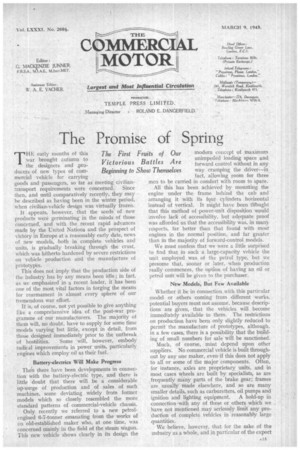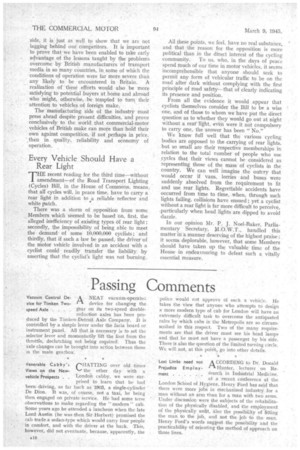The Promise of Spring
Page 17

Page 18

If you've noticed an error in this article please click here to report it so we can fix it.
The First Victorious Beginning to
THE early months of this war brought autumn to the designers and ,producers of new types of commercial vehicle for carrying goods and passengers, so far as Meeting civiliantransport requirements were concerned. Since then, and until comparatively recently, they may be described as having been in the winter period, when civilian-vehicle design was virtually frozen.
It appears, however, that the seeds of new products were germinating in the minds of those concerned, and with the recent rapid advances made by the United Nations and the prospect of victory in Europe at a reasonably early date, news of new models, both in complete vehicles and units, is gradually breaking through the crust, which was hitherto hardened by severe restrictions on vehicle production and the manufacture of prototypes. This does not imply that the production side of the industry has by any means been idle ; in fact, as we emphasized in a recent leader, it has been one of the most vital factors in forging the means for rearmament in almost every sphere of our tremendous war effort.
It is, of course, not yet possible to give anything Eke a comprehensive idea of the post-war programme of our manufacturers. The majority of them will, no doubt, have to supply for some time models varying but little, except in detail, from those designed immediately prior to the outbreak of hostilities. Some will, however, embody radical improvements in power units, particularly engines which employ oil as their fuel.
Battery-electrics Will Make Progress Then there have been developments in connection with the battery-electric type, and there is little doubt that there will be a considerable up-surge of production and of sales of such machines, some deviating widely from former models which so closely resembled the more standard patterns of commercial-vehicle chassis. Only recently we referred to a new petrolengined 6-7-tormer emanating from the works of an old-established maker who; at one time, was concerned mainly in the field of the steam Wagon. This new vehicle shows clearly in its design the
Fruits of Our Battles Are Show Themselves
modern concept of maximum unimpeded loading space and forward control without in any way cramping the driver—in fact, allowing room for three men to be carried in comfort with room to spare. . All this has been achieved by mounting the engine under the frame behind the cab and arranging it with its four cylinders horizontal instead of vertical. It might have been th'bught that this method of power-unit disposition would involve lack of accessibility, but adequate proof was afforded us that the accessibility was, in many respects, far better than that found with most engines in the normal position, and far greater than in the majority of forward-control models.
We must confess that we were a little surprised to find that in such • a large-capacity vehicle the unit employed was of the petrol type, but we presume that, sooner or later, when production really commences, the option of having an oil or petrol unit will be given to the purchaser.
New Models, But 'Few Available Whether it be in connection, with this particular model or others. coming from different works. potential buyers must not assume, because descriptions are given, that the vehicles will become immediately available to them. The restrictions on production have been only slightly reduced to permit the manufacture of prototypes, although, in a few cases, there is a possibility that the building of small numbers for sale will be sanctioned.
• Much, of course, must depend upon other suppliers. No commercial vehicle is built throughout by any one maker, even-if this does not apply to all or some of the major components. Often, for instance, axles are proprietary units, and in most cases wheels are built by specialists, as are frequently many parts of the brake gear; frames are usually made elsewhere, and so are many smaller details, such as carburetters, oil pumps and ignition and lighting equipment. A hold-up in connection with any of these or others which we have not mentioned may seriously limit any production of complete vehicles in reasonably large quantities.
We believe, however, that for the sake of the industry as a whole, and in particular of the export • side, it is just as well to show that we are not lagging behind our competitors. It is important to prove that we have been enabled to take early advantage of the lessons taught by the problems overcome by British manufacturers of transport media in so many countries, in some of which the conditions of operation were far more severe than any likely to be encountered in Britain. A realization of these efforts would also be more satisfying to potential buyers at home and abroad who might, otherwise, be tempted to turn their attention to vehicles of foreign make.
The manufacturing side of the industry must press ahead despite present difficulties, and prove conclusively to the world that commercial-motor vehicles of British make can more than hold their own against competition, if not perhaps in price, .then in quality, reliability and economy of operation.
Every Vehicle Should Have a Rear Light
THE recent reading for the third time—without amendment—of the Road Transport Lighting (Cycles) Bill, in the House of Commons, means, that all cycles will, in peace time, have to carry a rear light in addition to a reliable reflector and white patch.
There was a storm of opposition from some Members which seemed to be based on. first, the alleged inefficiency of existing types of rear light ; secondly, the impossibility of being able to meet the demand of some 10.000,000 cyclists ; and thirdly, that if such a law be passed, the driver of the motor vehicle involved in an accident• with a cyclist could readily transfer the liability by asserting that the cyclist's light was not burning. All these points, we feel, have no real substance, and that the reason for the opposition is more political than in the direct interest of the cycling community. To us, who, in the days of peace spend much of our time in motor vehicles, it seems incomprehensible that anyone should seek to permit any form of vehicular traffic to be on the road after dark without complying with the first principle of road safety—that of clearly indicating its presence and position.
From all the evidence it would appear that cyclists themselves consider the Bill to be a wise one, and of those to whom we have put the direct question as to whether they would go out at night without a rear light, even were it not compulsory to carry one, the answer has been " No."
We know full well that the various cycling bodies are opposed to the carrying of rear lights. but so small are their respective memberships in relation to the total number of people who use cycles that their views cannot be considered as representing those of the mass of cyclists in the country. We can well imagine the outcry that would occur if vans, lorries and buses were suddenly absolved from the requirement to fit and use rear lights. Regrettable accidents have occurred from time to time, when, through such lights failing, collisions have ensued ; yet a cyclist without a rear light is far more difficult to perceive, „particularly when head lights are dipped to avoid dazzle.
In our opinion Mr. P. J. Noel-Baker, Parliamentary Secretary. )4.0.W.T., handled this matter in a manner deserving of the highest praise ; it seems deplorable, however, that some Members should have taken up the valuable time of the House in endeavouring to defeat such a vitally essential measure.





















































